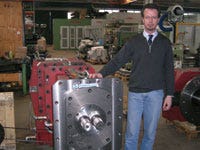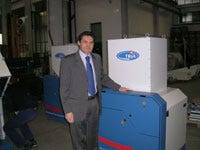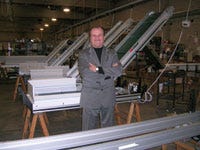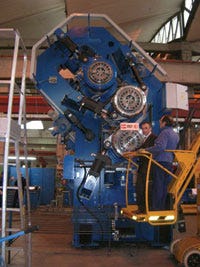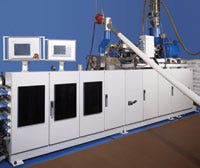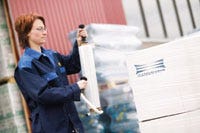Processing world focuses on Milan this month
This year’s Plast 2009 show in Milan, Italy promises to provide cost-effective plastics processing solutions for tough times. MPW will attend the triennial event and report back, but here, based on a trip through Italy early this year, we present some of the highlights that can be seen at the show from March 24-28.Zambello Riduttori Srl
March 11, 2009
This year’s Plast 2009 show in Milan, Italy promises to provide cost-effective plastics processing solutions for tough times. MPW will attend the triennial event and report back, but here, based on a trip through Italy early this year, we present some of the highlights that can be seen at the show from March 24-28.
Zambello Riduttori Srl
Customers and prospects will have the chance not only to see equipment at the show (stand 13B06), but also to view operating gearboxes at an open house at the plant in Magnago, Italy, a short ride from the fair grounds.
|
Zambello is promoting its redesigned MHP3 gearbox for injection molding equipment. The unit’s torque remains the same but improvements in water cooling bring higher motor efficiencies. The concept can also be retrofitted on existing Zambello gearboxes. Alessandro Feller, export sales manager, sees a continuing demand for larger-sized gearboxes. The company is therefore showcasing its ZPE3/500, a three-stage gearbox for single-screw extruders used in heavy-duty processing. Gearbox cases are made so as to offer the possibility of using different thrust bearing sizes for a single gearbox dimension. In the last five years, the company has invested more than €5 million in new production technology, Feller says.
Tria SpA
|
Managing director Luciano Anceschi says demand for both post-production and post-consumer size reduction equipment continues to grow as countries around the world become more environmentally conscious and resins prices fluctuate. The company’s booth (24C-D23/24) is highlighting a line of grinders with either 11- or 26-kW motors to recycle vehicle bumpers and dashboards. Anceschi says high throughput for such applications (generally only 20-30 bumpers/24 hr) is not required by customers. Instead they are looking for equipment that can handle large pieces in a cost-effective way from energy and manpower standpoints. Tria says its unit produces homogeneous and clean regrind with low dust generation in a two-step process with just 85 db(A) of noise. So far the Tria (Cologno Monzese, Italy) units have helped solve recycling problems at Toyota, Honda, and Suzuki automotive plants.
Crizaf SpA
|
Separators and conveying systems are highlighting this company’s stand (24C-D21/22). Giuliano Boffi, sale manager at Crizaf (Saronno, Italy), says processors and packaging converters are telling him that they expect to be using the present tough times to improve their plant efficiencies. That’s also what his company did in February when it moved its warehousing into a new 6500m2 logistics center next to its existing production hall. The company used the space freed to better plan its production and assembly.This should help speed deliveries of, for example, 25 carousels and automated weighing stations made to accommodate Cleanroom 100,000 standards and set for delivery this year to pharmaceutical packaging operations in Switzerland and the U.K. At Plast, Crizaf is showing its Stock-box stocking system, a multi-level vertical storage station with bilateral charge and unloading. The unit includes a touch screen control box and an airflow feeding system.
Pomini Rubber & Plastics Srl
|
Compounders looking during the exhibition for equipment with higher throughput need to look no further than the Pomini booth (13C10) where the new VIC (Variable Intermeshing Clearance) “X” series is featured. This intermeshing batch mixer combines the ability of an open roll mill with the productivity of an internal mixer in a single machine. This is achieved through a patented feature of variable distance between the rotors. Pomini (Castellanza, Italy), part of the German-based Possehl Group, has increased the chamber volume of the unit. One innovative feature offered by the company is offering the “X” series enlarged chamber as a retrofit to existing VIC machines by changing its set of sides. The combination of a larger batch weight and shorter cycle times gives productivity increases of up to 20%, says the company.
Comerio Ercole SpA
|
Riccardo Comerio, managing director of this Busto Arsizio, Italy processing equipment builder, says customers today are paying increased attention to recycling options to better their profit margins. His company is emphasizing at its stand (18C09) the efficiencies of its ETP model family of recycling extrusion plants. This technology combines a thermoplastic matrix such as ethylene vinyl acetate (EVA) or polypropylene (PP) with filler such as rubber crumbs from tire waste, thermoplastic scrap from nonwovens, mineral fibers, or up to 75% wood flour. An ETP unit consists of a single-screw extruder with a patented mixing chamber. Two feeding points, the first for the matrix material and the second for the filler, mix and extrude a melt, then direct it to a calender. Comerio says by using a single- rather than a twin-screw extruder, the original features of the filler are better preserved without thermal aging. End products provide good insulation properties. Comerio Ercole will also offer Plast visitors a bus transfer to its plant for an open house during the show.
Macchi SpA
|
Extrusion line manufacturer Macchi (Venegono Inferiore, Italy) offers an off-the-shelf solution to efficiently recover processing waste. The company (stand 15C-D14/19) is featuring its Recotrim, a portable extruder that takes edge trim directly from a film line and converts it into granules that can be fed straight back into the main extruder. It can also reprocess more substantial waste from out-of-spec rolls. Macchi says Recotrim overcomes problems associated with edge trim recovery, such as how to handle the material that has picked up static charge, as well as variations in the amount of trim needed to be recovered. The unit is based around a short co-rotating twin-screw extruder running at low speed and low temperature to ensure minimal material degradation. It uses 80-mm screws, and heat is applied by ceramic elements grouped in two zones. Output is about 40 kg/hr. Two types of feeder can be used on the Recotrim hopper: a special hopper that separates trim from air, or a nip roll can be mounted on top of the hopper. Macchi calculates that a processor of 300-400 tonnes/yr can see savings of €20,000-€65,000/yr.
Torninova Srl
|
This bubble-wrap machine specialist located in Bastia Umbra, Italy, is demonstrating its Coex Bubble 10 line during the exhibition. The unit can coextrude up to 10-layer (ABCBA+ABCBA) bubble wrap that has good air retention barrier thanks to internal layers of nylon 6. Ricardo Marsili from Torninova (stand 15C-D12/17) says the fully automatic coextruxion process produces better cushioning protection compared to thicker, mono-extruded bubble wrap. It also allows a user to obtain better protection with a thinner film thanks to downgauging of the coextruded layers. Coex Bubble 10 uses one extruder for the polyethylene layers, one for the nylon barrier layer, and a third to extrude the tie layers. The machine at the company’s stand, already sold to an Italian packaging film processor, has a production width of 2.5m and an output of 650 kg/hr.
Reifenhäuser Extrusion GmbH
|
Demand for wood-polymer composites (WPC) is growing well in Europe thanks to new equipment for processing highly filled applications. Reifenhäuser (Troisdorf, Germany) at Plast features its Bitruder counter-rotating intermeshing twin-screw extruder. Dieter Thewes, from the company’s Extrusion Center Division, says an output of 120-650 kg/hr can be achieved. The low screw speeds of this Reifenhäuser (stand 15D13) extruder aid in gentle plasticizing and homogenization, he adds.
Colines SpA
|
This equipment maker (stand 15A02) is featuring its Handrollex 1000 line cast coextrusion plants for the production of stretch-film reels for both manual and automatic wrapping. The company (Nibbia, Italy) claims this unit, producing stretch web in a width of 1000 mm, does not need a slitting machine since it produces manual as well as automatic film reels directly on 2- and 3-inch cores. Only one operator is required to handle production, and its compact layout helps processors save space. —[email protected]
About the Author(s)
You May Also Like
